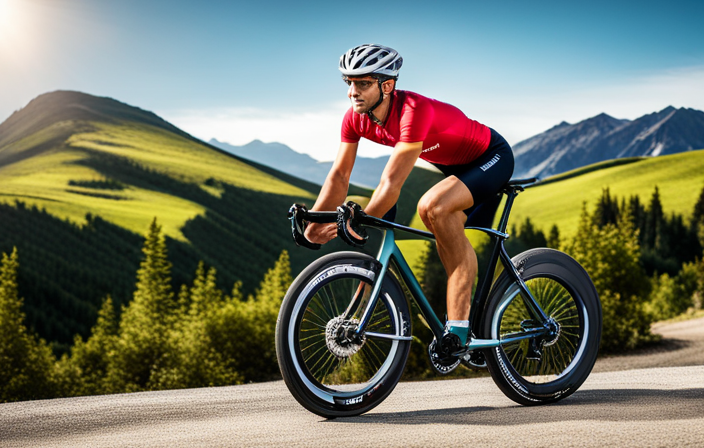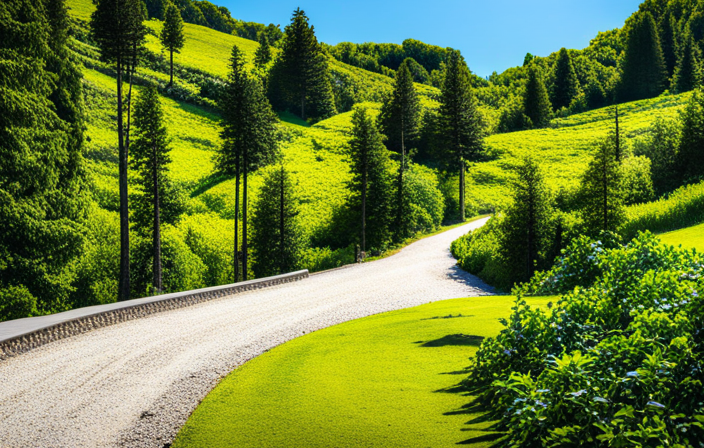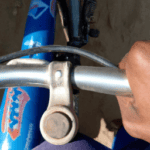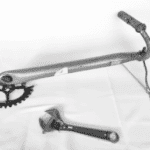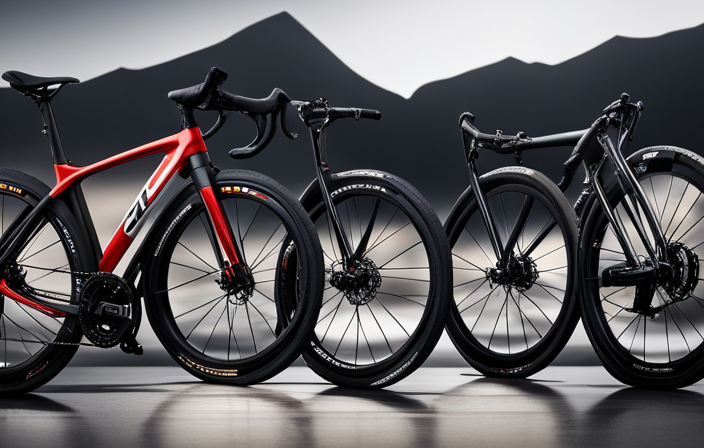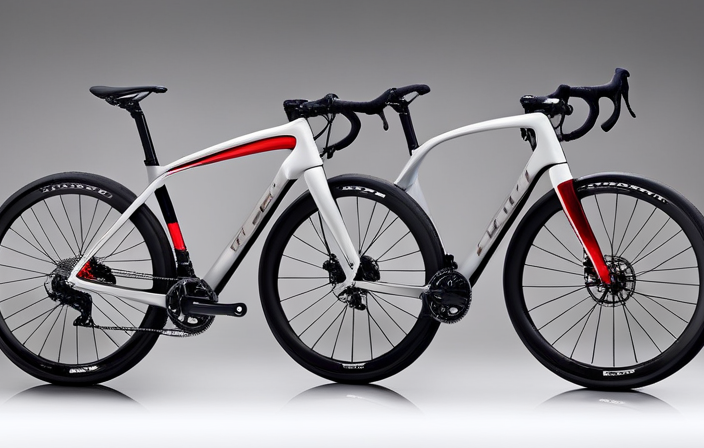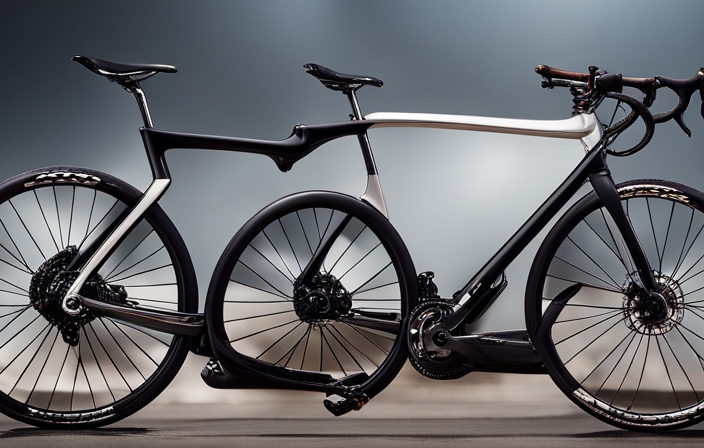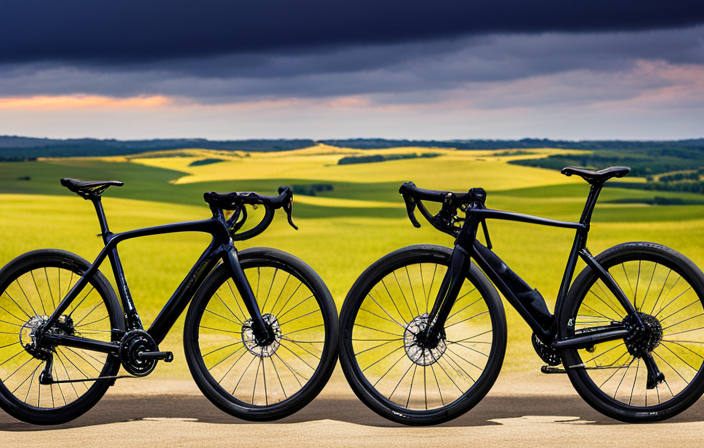Are you fed up with the discomfort of feeling like you’re perched on jagged rocks while cycling on your gravel bike? Don’t worry, I’m here to assist you in discovering the ideal saddle that will ensure your rides are smooth and comfortable.
In this article, we’ll explore the importance of choosing the right saddle for gravel biking and discuss factors such as riding style, comfort level, cushioning, width and shape.
So buckle up (pun intended) and let’s dive into the world of saddles for gravel bikes!
Key Takeaways
- Choosing the right saddle for gravel biking ensures a comfortable and enjoyable riding experience.
- Consider factors such as riding technique, saddle materials, and the balance between comfort and performance.
- Test ride different saddles and seek recommendations from bike shops and experienced gravel bikers.
- Proper care and maintenance, including cleaning and applying protective layers, can contribute to the longevity of the saddle.
Importance of Choosing the Right Saddle for Gravel Biking
Choosing the right saddle for gravel biking is crucial in ensuring a comfortable and enjoyable riding experience. Your saddle plays a key role in supporting your body and providing stability while navigating rough terrains. To make an informed decision, it’s essential to consider various factors, including your riding technique and the materials used in the saddle.
When it comes to riding technique, gravel biking demands a different approach compared to road or mountain biking. The unpredictable nature of gravel surfaces requires a saddle that can absorb vibrations and provide adequate cushioning. Look for saddles with extra padding or gel inserts to enhance comfort during long rides on bumpy terrain.
Additionally, considering the materials used in the construction of the saddle is vital. Many manufacturers offer saddles made from various materials such as leather, synthetic fabrics, or lightweight carbon fiber. Each material has its own benefits and drawbacks related to durability, weight, and flexibility. Take into account your personal preferences and prioritize finding a balance between comfort and performance.
Now that you understand the importance of choosing the right saddle for gravel biking based on riding technique and saddle materials, let’s move on to considering your riding style and positioning on the bike. Transitioning seamlessly into this next section will allow you to further fine-tune your choice for optimal comfort during those thrilling gravel adventures without compromising performance.
Consider Your Riding Style and Positioning on the Bike
When determining the best fit for my riding style and positioning on the bike, it’s important to consider factors such as comfort and support. Riding techniques play a significant role in choosing the right saddle for gravel biking. Whether you prefer an aggressive riding position or a more relaxed one, your saddle should accommodate your specific needs.
When considering comfort and support, there are several key features to look for in a saddle. Firstly, the shape of the saddle plays a crucial role in providing adequate support to different parts of your body. Secondly, the padding material used can greatly impact comfort during long rides. Finally, the width of the saddle should be considered based on personal preference and anatomical differences.
To help visualize these considerations, imagine a saddle that contours perfectly to your body shape, providing optimal support where needed. Picture yourself gliding effortlessly over rough terrains with minimal discomfort due to strategically placed padding. And envision a saddle width that allows you to maintain proper alignment without causing any pressure points.
By assessing my level of comfort and support needed through these considerations, I can confidently choose a suitable saddle for my gravel bike adventures.
Assess Your Level of Comfort and Support Needed
To assess your level of comfort and support needed, it is important to consider factors such as your riding style and positioning on the bicycle. Assessing comfort involves understanding how your body interacts with the bike and identifying any areas of discomfort or pain that may arise during longer rides. Support, on the other hand, refers to the amount of stability and cushioning provided by the saddle.
When evaluating comfort, take note of any pressure points or numbness that you experience while cycling. These can indicate a need for a saddle with additional padding or cutouts to relieve pressure on sensitive areas. Additionally, consider your riding position. Are you more upright or do you prefer a more aggressive posture? This will help determine whether a wider or narrower saddle is best suited for you.
To ensure proper support, look for saddle designs that provide cushioning and shock absorption. Some saddles feature gel inserts or foam padding that can help absorb vibrations from rough gravel roads. Others may have springs or elastomers built into their design to enhance comfort.
By assessing your level of comfort and support needed based on these factors, you can make an informed decision when selecting a saddle for your gravel bike.
Look for Saddle Designs that Provide Cushioning and Shock Absorption
Consider searching for saddle designs that offer cushioning and shock absorption to enhance your riding experience. When it comes to gravel biking, having a saddle that provides adequate cushioning is crucial, as it helps reduce discomfort during long rides on rough terrains. Additionally, shock absorption features can further minimize the impact of bumps and vibrations, ensuring a smoother and more enjoyable ride.
Here are three key features to look for in saddle designs that prioritize cushioning technology and shock absorption:
-
Gel padding: Saddle models with gel padding distribute pressure evenly across your sit bones, providing excellent comfort and reducing the chances of soreness or numbness.
-
Suspension systems: Some saddles feature built-in suspension systems that absorb shocks from uneven surfaces. These systems typically include springs or elastomers that effectively absorb vibrations, allowing you to maintain better control over your bike.
-
Flexible materials: Saddles made from flexible materials such as carbon fiber or high-density foam can provide superior cushioning while maintaining durability. These materials have the ability to adapt to your body’s contours, offering optimal support where you need it most.
By considering these cushioning technologies and shock absorption features when choosing a saddle for your gravel bike, you can ensure a more comfortable and enjoyable ride.
Now let’s delve into determining the width and shape that fits your body and riding style…
Determine the Width and Shape that Fits Your Body and Riding Style
Finding the right width and shape that suits your body and riding style is essential for a comfortable and enjoyable ride. When choosing the right saddle shape and width for optimum comfort and performance, there are several factors to consider.
Firstly, consider your body type and sit bone width. Your sit bones should be supported by the widest part of the saddle, so it’s crucial to measure the distance between them accurately. Most bike shops offer specialized tools to determine your sit bone width.
Additionally, think about your riding style. If you tend to adopt an aggressive, aerodynamic position, you may prefer a narrower saddle that allows for more freedom of movement. Conversely, if you prefer a more upright position or have a wider pelvis, a wider saddle with more support may be more suitable.
Furthermore, take into account the shape of the saddle itself. Some saddles feature cutouts or channels in the center to relieve pressure on sensitive areas like the perineum. Others have a flatter profile or are slightly curved from front to back. Experimenting with different shapes can help you find one that provides maximum comfort for your anatomy.
Considering these factors will help you narrow down your options when selecting a saddle that fits your body and riding style perfectly.
Now let’s move on to considering the material and construction of the saddle…
Consider the Material and Construction of the Saddle
When choosing a saddle, it’s important to take into account the materials used and how it is constructed. The material and construction of a saddle can greatly impact your comfort and performance on your gravel bike.
There are several factors to consider when making your saddle choice.
Firstly, consider the material of the saddle. Most saddles are made from either leather, synthetic materials like nylon or carbon fiber, or a combination of both. Leather saddles are known for their durability and ability to conform to your body over time, providing a personalized fit. Synthetic materials tend to be lighter in weight and offer more flexibility in terms of shape and design.
Secondly, consider the construction of the saddle. Look for features such as cutouts or channels that help relieve pressure on sensitive areas. Additionally, some saddles have padding or gel inserts for added comfort.
In conclusion, when choosing a saddle for your gravel bike, it’s important to consider both the material and construction of the saddle. These factors will determine how comfortable you feel during long rides on rough terrain. With the right combination of material and construction features, you can enhance stability and control on gravel terrain without compromising comfort or performance.
Look for Saddle Features that Enhance Stability and Control on Gravel Terrain
To enhance stability and control on rough terrain, you should look for saddle features that cater to the demands of gravel riding. When it comes to riding techniques on gravel, there are a few key factors to consider in order to have a comfortable and confident ride. One important aspect is the shape of the saddle. A wider rear section provides more support and stability, allowing you to maintain control over uneven surfaces. Additionally, a slightly curved profile can help prevent your body from sliding forward during intense pedaling efforts.
In terms of saddle materials, durability is crucial for off-road riding. Look for saddles made from high-quality materials such as carbon-reinforced nylon or synthetic leather, which can withstand the rigors of gravel trails without sacrificing comfort. Some saddles also feature strategic padding in areas where pressure points may occur, helping to reduce discomfort during longer rides.
Consider incorporating these features into your search for a gravel bike saddle:
| Feature | Benefit |
|---|---|
| Wider rear section | Increased stability |
| Slightly curved profile | Prevents sliding forward |
By selecting a saddle with these characteristics, you’ll be better equipped to tackle challenging terrain with confidence and control. Next, let’s discuss how test riding different saddles can help you find the perfect fit without compromising comfort.
SUBSEQUENT SECTION: ‘Test Ride Different Saddles to Find the Perfect Fit’
Test Ride Different Saddles to Find the Perfect Fit
Try out various saddles to discover the ideal fit for you and ensure maximum comfort while riding. When it comes to finding the right saddle for your gravel bike, nothing beats actually experiencing how it feels during a test ride. Test riding different saddles has numerous benefits that can greatly enhance your overall riding experience.
Firstly, test riding allows you to physically feel how each saddle fits your body shape and size. Everyone’s anatomy is unique, so what works for one person may not work for another. By trying out different saddles, you can determine which one provides the best support and alleviates any pressure points.
Secondly, test riding gives you the opportunity to assess stability and control on gravel terrain. Gravel biking requires more stability compared to road cycling due to uneven surfaces. So, testing different saddles will allow you to gauge how well they keep you balanced and in control when navigating through rough terrains.
To further refine your search for the perfect saddle, seek recommendations from experienced gravel bikers or bike shops. They often have valuable insights based on their own experiences and knowledge of various saddle options available in the market.
Incorporating these steps into your search will help you find a saddle that not only fits properly but also enhances stability and control during your gravel adventures.
Seek Recommendations from Experienced Gravel Bikers or Bike Shops
If you want valuable insights and advice on finding the perfect fit for your gravel adventures, seek recommendations from experienced gravel bikers or bike shops. These individuals have firsthand experience with different saddles and can provide valuable feedback based on their own trials and errors. Here are three reasons why seeking recommendations from these sources is a great idea:
-
Bike shop recommendations: Bike shops are staffed by knowledgeable professionals who understand the intricacies of saddle selection. They can assess your body geometry, riding style, and preferences to recommend a saddle that will provide optimal comfort and performance on gravel terrain.
-
Experienced gravel bikers recommendations: Gravel biking enthusiasts who have spent countless hours exploring rough terrains know what works best in terms of saddle comfort and performance. They can share their personal experiences, highlight specific brands or models that excel in off-road conditions, and offer insights into what features to prioritize.
-
Hands-on comparison: By seeking recommendations from both bike shops and experienced riders, you’ll be able to gather multiple perspectives and opinions. This will allow you to make an informed decision when selecting a saddle that suits your needs best.
When considering the next step about taking personal preferences into account (such as weight or durability), it’s important to remember that finding the right fit is a combination of expert advice along with aligning your individual priorities.
Take into Account Personal Preferences and Priorities (Weight, Durability, etc.)
Consider your personal preferences and priorities, such as weight and durability, when choosing the right saddle for your gravel biking adventures. Finding the balance between weight and durability is crucial because you want a saddle that is lightweight enough to enhance your performance on the bike, but also durable enough to withstand rough terrains and long rides. Some riders prioritize weight over durability, opting for lightweight carbon fiber saddles that can reduce overall bike weight. However, it’s important to note that these may not be as durable in the long run compared to saddles made from more robust materials like leather or synthetic leather.
Another aspect to consider is the type of padding in the saddle. Personal preferences play a significant role here, with some riders preferring gel padding for its extra cushioning effect, while others opt for foam padding for its supportive yet firm feel. Gel padding provides excellent comfort during long rides but may not be as durable as foam padding.
When considering the longevity and maintenance of the saddle, it’s essential to think about factors like weather resistance and ease of cleaning. These aspects will contribute to preserving your saddle’s lifespan and ensuring optimal performance throughout your gravel biking endeavors.
With these factors in mind, it’s important to also consider the longevity and maintenance of your chosen saddle.
Consider the Longevity and Maintenance of the Saddle
To ensure the longevity and easy maintenance of your chosen saddle, it’s important to regularly clean and protect it from weather elements. This will not only prolong its lifespan but also contribute to its overall performance. When considering longevity versus performance, it’s crucial to strike a balance that meets your specific needs. Some saddles may prioritize durability over weight savings, while others may focus on providing maximum comfort without sacrificing durability.
Maintenance versus comfort is another factor to consider when choosing a saddle for your gravel bike. While some riders may prefer low-maintenance options that require minimal care, others might prioritize the utmost comfort during long rides. It’s essential to find a saddle that aligns with your preferences in this regard.
Taking proper care of your saddle involves regular cleaning and protection from rain, sun exposure, and other weather conditions. Cleaning can be done using mild soap and water, followed by applying a protective layer such as silicone-based spray or wax.
When transitioning into the next section about looking for saddle brands with positive reviews and reputation, it’s important to note that these steps will help you make an informed decision about which brand or model to choose. By considering factors such as longevity, maintenance, comfort, and performance in conjunction with positive reviews and reputation of various brands, you can find the perfect saddle for your gravel bike.
Look for Saddle Brands with Positive Reviews and Reputation
When looking for a saddle brand, it’s important to prioritize those with positive reviews and a reputable reputation. Consider what other riders have experienced with the brand before making your decision. Here are four key reasons why you should look for saddle brands with positive reviews and a good reputation:
-
Saddle Material Comparison: A reputable brand will use high-quality materials in their saddles, ensuring durability and comfort. Look for brands that offer different materials such as carbon fiber, titanium, or synthetic leather to find the one that suits your preferences.
-
Saddle Design Innovation: Brands with positive reviews often invest in research and development to create innovative designs that improve comfort and performance. They may incorporate features like pressure relief channels, ergonomic shapes, or flexible frames to enhance your riding experience.
-
Reliable Customer Feedback: Positive reviews indicate satisfied customers who have tested the saddle’s quality over time. You can trust their feedback when it comes to factors like durability, comfort, and overall satisfaction.
-
Established Reputation: A brand’s reputation is built on reliability and customer satisfaction. Choosing a well-known brand ensures you are buying from a company that has consistently delivered high-quality products.
Considering these factors will help you narrow down your options when choosing a saddle brand for your gravel bike. Now let’s move on to considering the price range and budget for your saddle without compromising on quality and performance…
Consider the Price Range and Budget for Your Saddle
Finding a saddle that fits within your budget is essential for ensuring you get the best value for your money. When considering the price range and budget for your saddle, there are several factors to consider.
Firstly, think about the materials used in the construction of the saddle. Higher-end saddles often use premium materials such as carbon fiber or leather, which can significantly increase their price. However, there are also more affordable options available that still offer good comfort and durability.
Another factor to consider is the level of padding and cushioning in the saddle. Some riders prefer a firmer saddle with minimal padding, while others prefer a softer and more plush feel. The amount of cushioning you need will depend on your personal preference and riding style.
Additionally, it’s important to take into account any additional features or technologies that may be included in the saddle. These can range from cut-outs or channels to relieve pressure on sensitive areas to adjustable rails and suspension systems for added comfort.
In conclusion, finding a saddle within your price range involves considering factors such as materials, padding, and additional features. By doing thorough research and comparing different options, you can find a saddle that meets both your budget requirements and provides optimal comfort for your gravel bike rides.
When choosing a saddle for your gravel bike, it’s also crucial to take proper measurements and consult a professional if needed.
Take Proper Measurements and Consult a Professional if Needed
It’s crucial to ensure you take proper measurements and consult a professional if necessary when selecting the right saddle. Consulting professionals who specialize in bike fitting can provide valuable insight and guidance based on your individual needs and body type. They can help you determine the correct width, shape, and padding that will best suit your anatomy and riding style. Taking accurate measurements is key to finding a saddle that will provide optimal comfort and support during long gravel rides.
To assist you in understanding the importance of taking proper measurements, here is a table that outlines the key measurement points for finding the right saddle:
| Measurement Point | Description |
|---|---|
| Sit Bone Width | Measure between your sit bones to determine the appropriate saddle width. |
| Pubic Arch Width | Measure the distance between your pubic bones to ensure proper support. |
| Perineum Relief | Consider a saddle with a cutout or groove to relieve pressure on sensitive areas. |
| Pelvic Rotation | Assessing your pelvic tilt can help determine the ideal shape of the saddle for better weight distribution. |
Remember that finding the right saddle may require trial and error as everyone’s preferences vary. However, by consulting professionals and taking accurate measurements, you are setting yourself up for success in finding a comfortable gravel bike saddle that enhances your riding experience.
Remember that Finding the Right Saddle may Require Trial and Error
Remember, it may take some trial and error to find the perfect fit for your ride. When it comes to finding the right saddle for your gravel bike, there are a few important things to keep in mind.
The importance of trial and error cannot be stressed enough when it comes to something as personal as saddle comfort. Here are three key points to consider during this process:
-
Patience: Finding the right saddle can be frustrating at times, but it’s crucial not to rush the process. Take your time and try out different options until you find one that feels comfortable for you.
-
Adjustments: Remember that minor adjustments can make a big difference in how a saddle feels. Experiment with tilt angles, fore/aft position, and height until you achieve optimal comfort.
-
Feedback: Don’t hesitate to seek feedback from other riders or professionals who have experience with saddle selection. Their insights can provide valuable guidance and save you time in your search.
Finding the right saddle is essential for long rides on rough terrain. By embracing trial and error, being patient, making adjustments, and seeking feedback, you’ll be well on your way to finding the perfect fit for your gravel bike adventures.
Frequently Asked Questions
How do I determine the width and shape of a saddle that fits my body and riding style?
Determining the width and shape of a saddle that fits your body and riding style is crucial for comfort and performance.
To determine the right width, measure the distance between your sit bones using a specialized tool or through professional fitting services.
As for choosing the shape, consider factors like flexibility, riding position, and personal preference.
A more rounded shape suits riders who prefer an upright position, while a flatter shape is better for those with a more aggressive riding style.
What are some saddle features that enhance stability and control on gravel terrain?
When it comes to enhancing stability and control on gravel terrain, there are a few key saddle features to consider.
Firstly, saddle padding plays a crucial role in absorbing vibrations and providing comfort during rough rides.
Additionally, having the option for saddle width adjustment is beneficial as it allows for a customized fit that promotes balance and control.
These features ensure a more enjoyable and confident gravel biking experience.
How can I assess my level of comfort and support needed when choosing a saddle for gravel biking?
When assessing comfort and choosing a saddle for gravel biking, it’s important to consider your personal preferences and riding style.
Start by evaluating your sit bone width, as this will determine the saddle width that provides optimal support.
Next, think about the level of padding you need – more cushioning may be desired for longer rides.
Additionally, consider the shape of the saddle and whether it aligns with your anatomical needs.
Ultimately, finding the right balance between comfort and support is key for an enjoyable gravel biking experience.
Are there any specific material and construction considerations when selecting a saddle for gravel biking?
When selecting a saddle for gravel biking, it’s crucial to consider specific saddle materials and the importance of padding. The choice of materials can greatly affect comfort and durability.
Look for saddles made from lightweight yet strong materials like carbon or titanium, which provide a good balance between weight and strength.
Additionally, adequate padding is essential to absorb vibrations and shocks on rough terrain, ensuring a more comfortable ride over long distances.
How can I find the perfect fit for a saddle? Can you provide tips on test riding different saddles?
Finding the right saddle for your body and riding style can be a challenge, but with these tips, you’ll have no problem.
First, consider your sit bone width to find the appropriate saddle width.
Next, think about the shape and padding of the saddle to ensure comfort.
When test riding different saddles, pay attention to any pressure points or discomfort.
Lastly, don’t forget to adjust the saddle angle and height for optimal fit.
Happy riding!
Conclusion
In conclusion, choosing the right saddle for your gravel bike is crucial for a comfortable and enjoyable riding experience.
It’s important to consider factors such as your riding style, comfort needs, and body shape when selecting a saddle.
Remember that finding the perfect fit may require some trial and error, but it’s worth the effort to ensure optimal support and cushioning.
As the saying goes, "Don’t judge a book by its cover," don’t underestimate the impact of a well-chosen saddle on your gravel biking adventures.
Happy riding!
